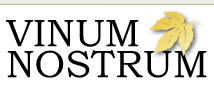Wine was the Greeks' favourite drink. Its taste, colour and alcoholic content had to be strong. Following the Egyptian custom, it was diluted with water in the proportion of 50%-70%. Only disreputable people, like the barbarians in the taverns at the Port of Piraeus in Athens, drank their wine straight. Wine was stored in vessels sprinkled with resin from conifer trees, giving it a particular aroma, still found today in the white wine called Retsina. Honey or aromatic herbs were sometimes added to preserve it. The wines of Lemnos, Pramnos and Chios were famous and widely diffused.
The Greeks in Basilicata
Basilicata is the territory, situated above the Greek colonies along the arc of the Ionian Sea, where the Oenotrians settled during the Middle Bronze Age. According to Herodotus, Oenotria was the land where grapevines grew tied to poles or reeds, instead of being supported by trees as in Campania and in Etruria, or on pergolas, as in the Brindisi area, or crawling on the ground as was the custom in Asia Minor.
Grape-growing on the Ionian coast
The first Greek colonists to arrive in southern Italy probably brought with them wine and grapevines. In the Ionian inland area, the site of Incoronata documents the presence of the grapevine, which likely grew around Metaponto as well. Over the remainder of the Italic soil, starting from the Iron Age, the characteristics of the grape seeds found increasingly resemble those of the cultivated grapevine, confirming the transition from merely gathering wild fruit to real cultivation.
Dionysus and wine: banqueting implements
Italic grave goods abound in implements and containers for preparing the customary drink, made by diluting wine in water and adding grated cheese and honey. Cheese-graters and kraters were thus objects symbolic of the symposium.
Ceramic tableware
Around the krater are wine cups of various types. The most important is the tall-stemmed kantharos; then come skyphoi, deep cups on low stems, and kylikes, broad shallow cups, either long- or short-stemmed. Ewers of medium size were used for pouring, such as the oinochoe (from the Greek oinos = wine, and cheo = pour), and the olpe, as well as dippers and single-handled jugs.
Italic-Mycenaean stemmed goblet
13th century B.C.
Metaponto, Museo Archeologico Nazionale
Inv. 47781-48130
Cup with fillet decoration on lip
Late 7th century B.C.
Policoro, Museo Archeologico Nazionale della Siritide
Inv. 205334
Deinos on support
Middle of the 7th century B.C.
Metaponto, Museo Archeologico Nazionale
Inv. 298978-298979
Kantharos with two-colour decoration
6th century B.C.
Policoro, Museo Archeologico Nazionale della Siritide
Inv. 215218
Black-figure cup
540-530 B.C.
Naples, Museo Archeologico Nazionale
Inv. Stg. 172
Red-figure kantharos
350-340 B.C.
Naples, Museo Archeologico Nazionale
Inv. Stg. 294
Rhyton with red-figure griffin protome
340-320 B.C.
Naples, Museo Archeologico Nazionale
Inv. Stg. 424
Red-figure amphora
c. 500-475 B.C.
Naples, Museo Archeologico Nazionale
Inv. Stg. 249
Red-figure oinochoe with lid
360-330 B.C.
Naples, Museo Archeologico Nazionale
Inv. Stg. 589
Flask-shaped vase
325-300 B.C.
Naples, Museo Archeologico Nazionale
Inv. 82480
Red-figure scroll krater
440-420 B.C.
Naples, Museo Archeologico Nazionale
Inv. 81870
Red-figure bell krater
Late 5th-early 4th century B.C.
Matera, Museo Archeologico Nazionale “D. Ridola”
Inv. 170763
Red-figure trefoil oinochoe
Middle of the 5th century B.C.
Metaponto, Museo Archeologico Nazionale
Inv. 20146
Red-figure bell krater
380-375 B.C.
Matera, Museo Archeologico Nazionale “D. Ridola”
Inv. 9577
Apulian figured oinochoe
First half of the 4th century B.C.
Melfi, Museo Archeologico Nazionale “M. Pallottino”
Inv. 345283
Two pairs of skewers
5th-4th century B.C.
Melfi, Museo Archeologico Nazionale “M. Pallottino”
Inv. 342797, 342797a, 342798, 342798a
Two pairs of firedogs
5th-4th century B.C.
Melfi, Museo Archeologico Nazionale “M. Pallottino”
Inv. 342799, 342800
Lamp
5th-4th century B.C.
Melfi, Museo Archeologico Nazionale “M. Pallottino”
Inv. 342785
Grate
5th century B.C.
Policoro, Museo Archeologico Nazionale della Siritide
Inv. 210420
Strainer
5th century B.C.
Policoro, Museo Archeologico Nazionale della Siritide
Inv. 215885
Basin
5th century B.C.
Melfi, Museo Archeologico Nazionale “M. Pallottino”
Inv. 338312
Silver phiale
Late 5th century B.C.
Melfi, Museo Archeologico Nazionale “M. Pallottino”
Inv. 331981
Trefoil oinochoe
First half of the 4th century B.C.
Melfi, Museo Archeologico Nazionale “M. Pallottino”
Inv. 334971
Griff-phiale
5th century B.C.
Policoro, Museo Archeologico Nazionale della Siritide
Inv. 215886
Simpulum
5th century B.C.
Metaponto, Museo Archeologico Nazionale
Inv. 22791
Cheese grater
6th century B.C.
Policoro, Museo Archeologico Nazionale della Siritide
Inv. 214919
Epychisis of Gnathia
4th century B.C.
Metaponto, Museo Archeologico Nazionale
Inv. 312524
Lebete
5th century B.C.
Melfi, Museo Archeologico Nazionale “M. Pallottino”
Inv. 338279
Kreagra
5th century B.C.
Melfi, Museo Archeologico Nazionale “M. Pallottino”
Inv. 338337
Black-figure kalathos
5th century B.C.
Metaponto, Museo Archeologico Nazionale
Inv. 319209
Red-figure bell krater
360-330 B.C.
Naples, Museo Archeologico Nazionale
Inv. 82582
Red-figure bell krater
415-400 B.C.
Naples, Museo Archeologico Nazionale
Inv. 145467
Red-figure bell krater
400-380 B.C.
Naples, Museo Archeologico Nazionale
Inv. Stg. 346
Red-figure bell krater
c. 440 B.C.
Naples, Museo Archeologico Nazionale
Inv. Stg. 281
Columned red-figure krater
c. 475-450 B.C.
Naples, Museo Archeologico Nazionale
Inv. 81403
Black-figure Attic pelike
c. 510 B.C.
Metaponto, Museo Archeologico Nazionale
Inv. 305254
Red-figure stamnos
c. 420 B.C.
Naples, Museo Archeologico Nazionale
Inv. 81674
Attic kalyx krater
5th century B.C.
Policoro, Museo Archeologico Nazionale della Siritide
Inv. 216360
Vase decorated with drunken satyr
350-300 B.C.
Naples, Museo Archeologico Nazionale
Inv. Stg. 93
Attic red-figure bell krater
440-430 B.C.
Metaponto, Museo Archeologico Nazionale
Inv. 9974
Red-figure kalyx krater
Middle of the 4th century B.C.
Matera, Museo Archeologico Nazionale “D. Ridola”
Inv. 13671
Red-figure bell krater
360-350 B.C.
Matera, Museo Archeologico Nazionale “D. Ridola”
Inv. 164506
Relief carving of Dionysus
Late 3rd-early 2nd century B.C.
Policoro, Museo Archeologico Nazionale della Siritide
Inv. 45275
Pinax with Dionysus
First half of the 4th century B.C.
Policoro, Museo Archeologico Nazionale della Siritide
Inv. 212199

















_60q.gif)




































